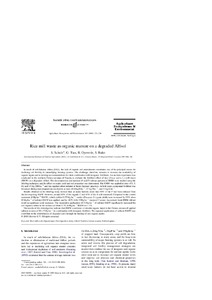| dc.contributor.author | Schulz, S. |
| dc.contributor.author | Tian, G. |
| dc.contributor.author | Oyewole, B. |
| dc.contributor.author | Bako, S. |
| dc.date.accessioned | 2019-12-04T11:23:49Z |
| dc.date.available | 2019-12-04T11:23:49Z |
| dc.date.issued | 2003-12 |
| dc.identifier.citation | Schulz, S., Tian, G., Oyewole, B. & Bako, S. (2003). Rice mill waste as organic manure on a degraded Alfisol. Agriculture, Ecosystems & Environment, 100(2-3), 221-230. |
| dc.identifier.issn | 0167-8809 |
| dc.identifier.uri | https://hdl.handle.net/20.500.12478/4168 |
| dc.description.abstract | In much of sub-Saharan Africa (SSA), the lack of organic soil amendments constitutes one of the principal causes for declining soil fertility in intensifying farming systems. The challenge, therefore, remains to increase the availability of organic inputs and to develop recommendations for their combination with inorganic fertilizers. An on-farm experiment was conducted in the northern Guinea savanna of Nigeria to evaluate the fertilizer effect of rice (Oryza sativa L.) mill waste (RMW) on a degraded Alfisol. The decomposition and nutrient (N and P) release patterns of RMW were studied using the litterbag technique, and the effect on maize yield and soil properties was determined. The RMW was applied at rates of 0, 5, 10, and 15 Mg DM ha−1 and was applied either unburnt or burnt (farmers’ practice). In both years, compound fertilizer was broadcast during land preparation on all plots at rates of 40 kg N ha−1, 17 kg P ha−1, and 33 kg K ha−1. Results obtained in the litterbag study showed that, at maize harvest, more than 90% of the P had been released from the decomposing RMW. However, around 60% of the organic C and 45% of the N still remained. Compared to the control treatment (0 Mg ha−1 RMW), which yielded 0.55 Mg ha−1, maize (Zea mays L.) grain yields were increased by 95% when 10 Mg ha−1 of unburnt RMW was applied, and by 147% with 15 Mg ha−1 (mean of 2 years). In contrast, burnt RMW did not result in significant yield increases. The cumulative application of 30 Mg ha−1 of unburnt RMW significantly increased the soil organic carbon in the surface soil from 0.7% (0 Mg ha−1 RMW) to 1.3%. The results of this investigation indicate that RMW constitutes a valuable organic input in the Guinea savanna if applied unburnt at rates of 10–15 Mg ha−1 in combination with inorganic fertilizer. The repeated application of unburnt RMW may contribute to the rehabilitation of degraded soils through the buildup of soil organic matter. |
| dc.language.iso | en |
| dc.subject | Rice |
| dc.subject | Alfisol |
| dc.subject | Nutrient |
| dc.subject | Farming Systems |
| dc.title | Rice mill waste as organic manure on a degraded Alfisol |
| dc.type | Journal Article |
| dc.type | Journal Article |
| dc.description.version | Peer Review |
| cg.contributor.affiliation | International Institute of Tropical Agriculture |
| cg.coverage.region | Africa |
| cg.coverage.region | West Africa |
| cg.coverage.country | Nigeria |
| cg.isijournal | ISI Journal |
| cg.authorship.types | CGIAR single centre |
| cg.iitasubject | Soil Health |
| cg.iitasubject | Farming Systems |
| cg.accessibilitystatus | Limited Access |
| local.dspaceid | 99734 |
| cg.identifier.doi | https://doi.org/10.1016/S0167-8809(03)00198-1 |

